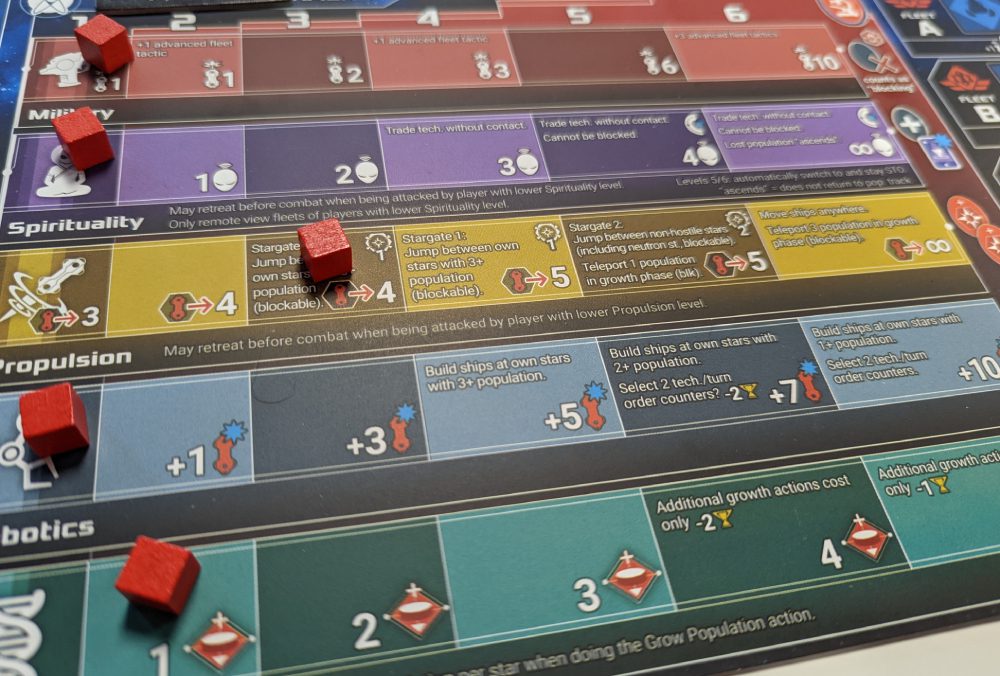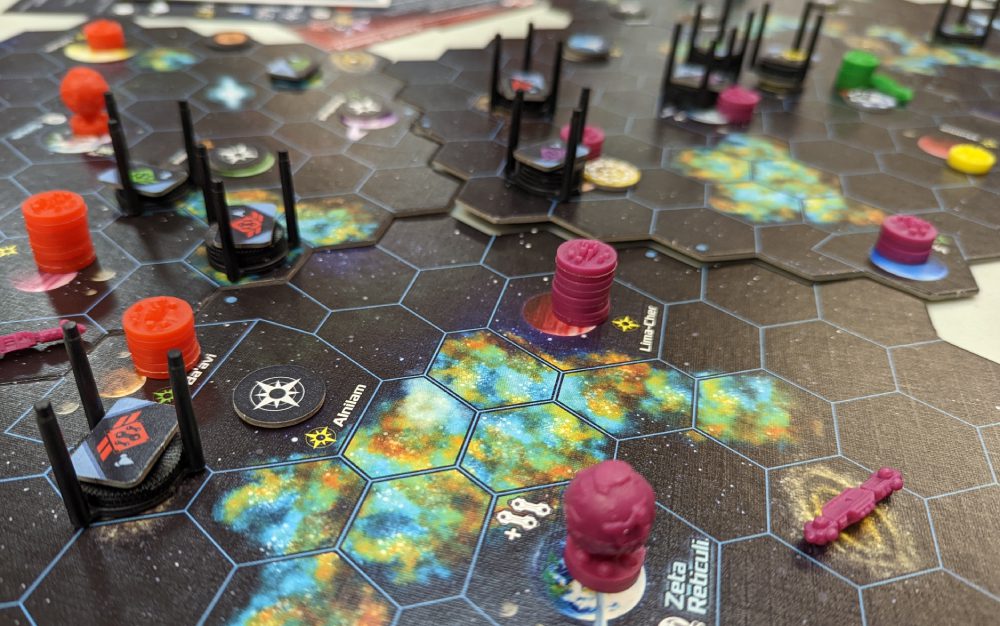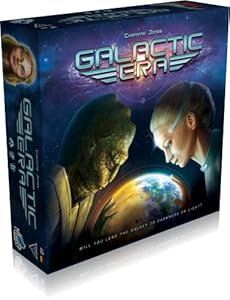Disclosure: Meeple Mountain received a free copy of this product in exchange for an honest, unbiased review. This review is not intended to be an endorsement.
Nine.
That’s the number of times I’ve played this game, and I typically avoid games that take three hours to finish. It doesn’t help that it comes with a 40-page rulebook, and despite my elite-level teaching abilities (no, I will not be humble about this), it will take a solid half an hour of my time to get the new players up to speed with this 4x game.
For those who don’t know, 4x stands for eXplore, eXterminate, eXploit, and eXpand. It’s a subgenre of strategy games that often involve starting as a small empire and painting the rest of the galaxy, world, land, or whatever in your color. The genre has earned a reputation for being long, complex, and hostile towards new players.
Every story has a beginning
Galactic Era’s premise is much like any other game of this type. You have eight rounds, and you want to grab the most Victory…I mean Destiny Points by the end of the game. There are several ways to accomplish this.
The easiest way is to throw as many population discs as onto the hexagonal map. You also start with a Domination card, which is your secret goal. The Galactic Goal serves as the public objective of the session. The Galactic Story determines how players earn points, such as winning fights or growing their population. At the end of the game, the player with the most ships in each sector tile will score extra points.
Okay, I’ll admit that was a lot to take in. Aside from the numerous ways to score points, this game also includes Star People, this game’s version of a race. Of course, the Star People have their special powers as expected in the 4x genre, with one crucial change: You pick their alignment.
You can be STO (Service to Others) or STS (Service to Self). Good or Evil. Your alignment will dictate how you interact with the game and announce your intentions to your opponents. For example, STO cannot declare war on other STO players, cannot touch primitive stars, and can only declare war on STS players if they plan on taking over a populated star. You can clearly see how your civilization grows not only through colors on a map or technology but also in terms of culture and ethics. Also, switching between the two alignments is an available option throughout the game.

Gotta go fast
A round goes through four phases. The first is Movement, where you move your ships and fleets around the galaxy. A ship is a simple single ship, while a fleet is a stack of ships under one banner with the number of ships hidden from your opponents in the form of face-down numbered chips. This banner represents a fleet type, giving the fleet a power such as extra combat value or moving a bit further.
After Movement is the Growth phase. It is here where you choose which areas to improve, switch alignments, and change turn order. You can build ships, research technologies, increase your population, or gain stars. These actions are picked simultaneously and in secret. Once revealed, everyone does their bit.
Following Growth comes Trading. Anyone who is in contact with another player gets to trade. Contact means their ship is in the same space as another player’s ship or star. If they are, they can agree to trade technology. That’s it.
The final stretch is the Scoring. Depending on the Galactic Story used in the game, players will score points if they meet certain conditions like what alignment they are or winning fights.
Do this 8 times and whoever has the most Destiny Points wins.
A lesson in opportunity cost
Galactic Era is one of the many complex games where the turn mechanisms are surprisingly easy to grasp, but the actions and outcomes often come with asterisks and conditions. The 40-page rulebook is 40 pages for a reason.
One of the many appreciations I have for Galactic Era is it keeps the spirit of the 4x genre intact without conscripting its players to a battlefield of aggravation. Let’s be honest here, 4x games are about moving ships and choosing what to grow, and Galactic Era’s Growth phase emulates these decisions perfectly fine despite its simplistic approach.
The Growth phase does deserve a bit more praise outside of its modest nature. There are five actions to choose from, but you can only pick two. Players face a cost opportunity problem and must craft their strengths and weaknesses. Metagaming-wise, this means that players are very close to one another in terms of progress.
This “pick two” system isn’t static. The population discs you put on your stars can stack up, and the higher the stack, the more things you can do. One of these perks can play additional growth actions at the cost of some Destiny Points. Not only do you need to increase your population, but you need to know if getting that extra growth action is worth losing a few points. An easy-to-understand system. Nice.
Blind date with knowledge
The same limitations apply to technology as well. You have five technology paths to research, and each technology has six levels. Remember, you can only pick one per Growth phase, so maxing out in one technology path requires committing a good portion of the eight rounds towards it. There are other ways to progress in technology, such as trading and going for the central sector map tile for artifacts. Don’t be surprised—this is a 4x space board game, and the middle is always important.
Technology works well here since it’s more than just numbers getting higher. As you advance towards the end of a path, you unlock new abilities to exploit. Unlike other games, the powers here are absolute game changers and give you a power trip like you just became a Reddit Moderator. For example, if you max out on Propulsion, the technology that allows your ships to move, numbers no longer matter. You pick a spot and go. Spirituality will allow you to trade technology with other players without contacting them and when maxed out, your “killed” population discs still score since they have ascended.
What’s fascinating about this setup is the technological decisions made by the players can drastically change everyone’s approach to the game. If Propulsion isn’t researched by anyone, players will have a tough time reaching much beyond their own borders and start developing their own real estate like an intergalactic Black Rock subsidiary. Yet if Military and Robotics are the focal points, expect paranoia, an arms race, and volatile borders. Also, it’s hard to max out on a single tech and it comes across as more of a rare event than the standard, which is a big plus since it keeps the game unpredictable along with the random Galactic goals, Galactic story, Star people, and Domination cards.
Spirituality is the one that grabbed my attention. Besides an area of science fiction that barely gets touched, Spirituality rewards you with Remote Views. Stars and artifacts tokens are face down, and Remote Views allow you to view any single token, distance be damned. If you have a higher Spirituality than your opponent, you can also look at one of their fleets to get the exact number of ships and the fleet type. This is quite powerful because you might have to fight, either to gain ground or to keep what you have.

A polite destruction
One of Galactic Era’s main selling points is the combat system doesn’t use dice, but it also doesn’t use cards or an auction system which tends to be the flavor for deterministic combat systems.
When two hostile fleets meet, the first step is to check if the defender can retreat. If the defender is using an E fleet type, has a higher Spirituality, or higher Propulsion, they have the option to leave. If they don’t, then all of the hidden ships are revealed. Count the number of ships multiplied by the combat value. Both Military Technology level and fleet type determine the combat value. The player with the higher number wins.
The winner of the combat determines the losses of the defender, with one catch: The winner loses half of the declared losses unless they won the combat by three times, then they lose nothing.
By far, this is my favorite deterministic combat system. Many games that use auctions or cards to resolve their combat often take several minutes to resolve, murdering the pacing. Furthermore, while it is true that those games tend to have an input you can control, the output still relies on you crossing your fingers and hoping for the best. They come across as a complicated way not to use dice.
Galactic Era’s combat system is easy to understand, resolves in less than a minute, and feels fair for both sides. If you lose, your opponent outplayed you. If you win, there were a series of steps that lead to that victory. While it lacks the drama and fireworks of other combat systems, it is functional and rewarding all the same.
Cracks in the vessel
I could go on and on, but these are the highlights that hooked me on Galactic Era. It is my favorite 4x game, but is it perfect? I wish.
An easy one to talk about is aesthetics. The art works well enough and reminds me of playing an early 90s PC strategy game. The issue lies in the generic nature of the art direction.
You have Star People that are mainly animals, organizations that are noticeable references to popular science fiction franchises, and even the name of the stars can’t stop pointing out its passion for the genre. Galactic Era looks like Master of Orion and Star Trek with the barcode covered in black marker.
Continuing on this topic of visual language, the way it handles fleets is a bit jarring. You have a stack of black chips face down with a black “fleet holder” that looks like an upside-down pizza table. While it does keep the stack organized, it visually looks out of place. In terms of functionality, the constant shuffling of chips when moving from one fleet to another, or examining them via Spirituality, is far more fiddly than necessary. You will feel the pain of this in the mid and late game as fleet movement and combat become a central point.

How not to become an icon
It doesn’t end there. There is an absurd abuse of icons with a cast of 49 of them. Galactic Stories and Galactic Goals are communicated primarily through these icons. Since this is public information, the only person that needs to translate it is the owner of the game. The issue arises when it comes to Domination cards, your hidden goal.
The Domination card has parts A and B. Part A’s objective is in plain English and tells you an effect when you reveal it. Part B is your consolation prize, and this is communicated strictly through icons. Not just icons, but a combination of icons to give it a whole new meaning. Even after playing this nine times, I still couldn’t grasp it. I had to create custom player aids for the Domination cards to keep everyone’s sanity in check.
Rule-wise, Galactic Era can sometimes feel like taking three scoops of pre-workout along with everything else. There are numerous details to remember, much like any other complicated game. Do expect your first or second game to be a rough ride, even if the rulebook is one of the best rulebooks I have ever read.
Intergalactic roommates
Enough with the negatives, what about player scaling? That’s an important question for any 4x game.
The review copy I have is the deluxe version, meaning I can play up to 6 players. The sweet spot here is 4, although 3 works out quite well. 5 to 6 players can work, however, the downtime will be noticeable in the second half of the game due to the importance of fleet movement. I prefer to stick to the lower player counts.
2 player games are where things get a bit weird. There is a third “puppet” player that players can bid their Destiny Points to control for that round. Due to backlash, the designer revamped the two-player mode and gave me a prototype rule set for this review. That’s the one I will be looking at.
There isn’t a “puppet” player anymore. In its place is a third player that is entirely passive. Their ships are sitting in their sectors, their stars have discs on them, and they have their tech. Movement is not something they do. The two players can interact with this “AI” third player to fight, trade, and even try to score the end game sector bonus.
As I have only played this once, I would consider this my first impression. Nevertheless, I was pleasantly surprised by how well it worked. Like Olympic-level fencing, every move felt highly calculated such as positioning, attacking, or defending. Because of Galactic Era’s infrastructure, with its technology and growth phase, winning or losing felt quite honest. It’s one of the few two-player games that I wouldn’t mind pulling out.
Galactic Era is one of the fairest strategy games I have ever played, as it keeps all the decisions one expects from a 4x game but emphasizes player skill over random outcomes. It could’ve used more bells and whistles in terms of visuals and presentation, especially with the icons, but the rules work so well with my brain that I am willing to ignore that. Galactic Era is a 4x game designed for people who like the genre yet don’t want to burden themselves with the many other games with a high time commitment or convoluted combat systems.












Add Comment